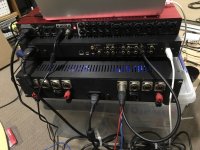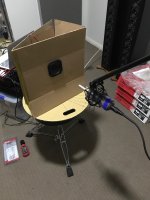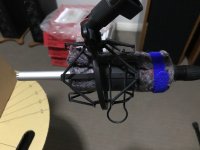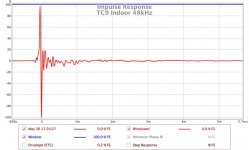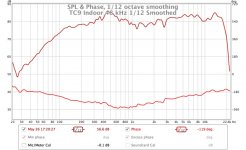I'll throw in a counter view...
Diffraction is one element that could point out to us where the sound is coming from. This would depend on several factors, as with anything in audio it's never simple as it's based on a lot of variables.
Disappearing speakers are often talked about in audio circles. I spend a lot of time searching for speakers that seem to excel at this.
Some of them do the disappearing act due to minimizing diffraction. However we determine location based on our own two ears. Having a small baffle helps to hide the speakers too. Even a very wide baffle can help make speakers disappear. Despite the presence of diffraction they will be harder to pin point with eyes closed (talking about the thin and very wide baffles).
All of these clues I found on that subject meant to me that all diffractive enclosures might not be or act equal.
I've had pretty big speakers (not a very wide baffle, just think PA size). Ugly rectangle ones with square corners. No matter how much processing I threw at them they never fully disappeared.
Ever try to pin point the origin of sounds by ears alone? Not trough speakers but real world sounds around you. I do it often and about anywhere I am. It's fun to see where and why we place the sounds and we can get pretty good at that game with some practice.
When listening to my arrays with eyes closed I have no clue where they are based on what I hear. That's what I wanted, that's what I got. I can move (within reason) without loosing that image where everything has it's own spot within the stage.
As mentioned above by BYRTT and X, reducing diffraction also reduces the FR differences that exist between of axis angles. Reducing diffraction can help to hide the original speaker position but also contribute to a wider sweet spot.
Less tonality changes when moving around is always a plus for me. I may have gone overboard, but i.m.h.o. without intruding on day to day life in my living room.
I'd say: the easier you make it on the brain to hear into the recording, the more convincing the music is going to sound. Isn't hearing a room enough of a distraction? We can never totally remove it until we step up to "studio like" environments. Yet we are seldom as aware of that room in our listening spot until we hear it back on a recording.
With arrays and a little help one can get pretty far. Despite the presence of comb filtering happening at the top end. It's there and it's real too. Another subject open for debate.
Diffraction is one element that could point out to us where the sound is coming from. This would depend on several factors, as with anything in audio it's never simple as it's based on a lot of variables.
Disappearing speakers are often talked about in audio circles. I spend a lot of time searching for speakers that seem to excel at this.
Some of them do the disappearing act due to minimizing diffraction. However we determine location based on our own two ears. Having a small baffle helps to hide the speakers too. Even a very wide baffle can help make speakers disappear. Despite the presence of diffraction they will be harder to pin point with eyes closed (talking about the thin and very wide baffles).
All of these clues I found on that subject meant to me that all diffractive enclosures might not be or act equal.
I've had pretty big speakers (not a very wide baffle, just think PA size). Ugly rectangle ones with square corners. No matter how much processing I threw at them they never fully disappeared.
Ever try to pin point the origin of sounds by ears alone? Not trough speakers but real world sounds around you. I do it often and about anywhere I am. It's fun to see where and why we place the sounds and we can get pretty good at that game with some practice.
When listening to my arrays with eyes closed I have no clue where they are based on what I hear. That's what I wanted, that's what I got. I can move (within reason) without loosing that image where everything has it's own spot within the stage.
As mentioned above by BYRTT and X, reducing diffraction also reduces the FR differences that exist between of axis angles. Reducing diffraction can help to hide the original speaker position but also contribute to a wider sweet spot.
Less tonality changes when moving around is always a plus for me. I may have gone overboard, but i.m.h.o. without intruding on day to day life in my living room.
I'd say: the easier you make it on the brain to hear into the recording, the more convincing the music is going to sound. Isn't hearing a room enough of a distraction? We can never totally remove it until we step up to "studio like" environments. Yet we are seldom as aware of that room in our listening spot until we hear it back on a recording.
With arrays and a little help one can get pretty far. Despite the presence of comb filtering happening at the top end. It's there and it's real too. Another subject open for debate.
Last edited:
That is a pretty small difference, but in the simulation that is a 1.5 inch roundover and it is not my understanding that the edge of the felt could be considered part of the roundover. So I doubt that would make any difference. I can't make the felt like that in any case. I did try to cut at a 45 degree angle but it just made a mess that looked terrible. Using more felt and extending it all the way past the roundover would probably make more difference but it is very expensive and would also look weird from the side. It is possible that the small roundover on the cabinet has done a good enough job by itself to reduce the worst of what might have been seen from a straight edge, who knows?Hi fluid,
Thanks felt measurements, know below suggestion is going into small shoes but it shows little improvements, diffraction can be EQed out but it changes a bit with distances but changes a lot with angle, suggestion is you make small strip of felt that will increase your round over radius, into spreadsheet you see data for middle driver blue curve verse grey curve going from 1 inch radius to 1,5 inch radius.
I suspect that you are right which is why I have not gone all out like wesayso did. I become less and less convinced of the absolute validity of some studies and opinions on which they are based over time as it is very hard to study and measure human perception. I still find them useful as they often show a general trend which can be good enough to work off.Diffraction is also one of those great audio bugaboos that gets a lot of attention and yet, it has been claimed by people such as Toole that it is inaudible. As BRYTT mentions, the peaks and dips change from small changes in location. This is precisely the type of response that our brain is able to filter out. It irritates the eyes more than the ears.
On the counter side if it is possible to make a change that can be verified as an improvement in a measurement and it isn't difficult or expensive then I see no reason to not include it.
I used 3M Scotchbrite scouring pads around my fullrange "dome" tweeter in a FAST setup and took measurements. They made the 600Hz to 3kHz range smoother in frequency space due to reduced diffraction. Maybe 1 to 2 dB little peaks (like grass) were smoothed out flatter. It was very subtle, but audible and measurable. As Byrtt says, increasing the roundover coverage will help.
You have used much more of the material in that build than I have on a per driver basis so I am not surprised to see a bigger difference. I did see some measurements on a site that showed quite a change from a small amount which is why I thought I would try it as it kills two birds with one stone so to speak as I needed something to lift the fabric away from the face of the drivers. I considered using Owen's method of an extra wooden moulding but I couldn't easily find one I liked and it was too much hassle to machine my own so I went with the felt.
In my measurements the biggest difference to be seen is in the the un-smoothed plots where the felt has reduced the grass at some points, it has also reinforced the comb filter dips higher up in some measurements too. Distance seems to negate those effects somewhat so it may be more noticeable on a nearfield monitor than a line array at a distance.
fluid,
Maybe it means nothing but notice your IR have kind of soft take off at attack side of IR, same had xrk971 before he went from think it was Dayton UMM-6 to miniDSP UMIK-1 USB microphone. Could it be sample rate converting inside Windows or hardware sample rate converting in your chain somewhere, below visual show what i mean in upper one is your single driver from post 394 verse lower one that is mine TC9 single driver measured in 192kHz chain and scaled as close to yours as eye could tweak.
Interesting observation Byrtt and you could be right. It is definitely not windows because these were measured on a Macbook Pro 😉 The Najda has an SRC built in like most DSP's and it cannot be switched off. It can only be 48, 96 or 192KHz.
I have left REW set to 44.1 forcing the SRC to kick in. I can change REW to 48KHz and retry. I can't listen to music that way as it is all in 44.1 which is why I didn't bother in the first place.
The scarlett is set to 44.1 because that was what I did the loopback calibrations at but that should not be an issue because the audio has gone from digital to analogue before that rate change happens.
I am using a Sonarworks calibrated measurement mic into the Scarlett, I don't have a USB mic.
There's is always likely to be debate over these sorts of issues. But I have never heard anyone say, "I put a huge roundover on my speaker and now it sounds worse". So you are at least on the safe side of the debate 😀I'll throw in a counter view...
I've had trouble trying to run 48 kHz sweep with Mac and REW in the past. Don't know if that issue has been fixed since.
...So I doubt that would make any difference...
Fine view i just FELT 😀 it was so easy to do and probably look great from outside sock.
Interesting observation Byrtt and you could be right. It is definitely not windows because these were measured on a Macbook Pro 😉 The Najda has an SRC built in like most DSP's and it cannot be switched off. It can only be 48, 96 or 192KHz.
I have left REW set to 44.1 forcing the SRC to kick in. I can change REW to 48KHz and retry. I can't listen to music that way as it is all in 44.1 which is why I didn't bother in the first place.
The scarlett is set to 44.1 because that was what I did the loopback calibrations at but that should not be an issue because the audio has gone from digital to analogue before that rate change happens.
I am using a Sonarworks calibrated measurement mic into the Scarlett, I don't have a USB mic.
Sounds as fine chain of gear there and sorry i brought Windows into picture here 😛 i would try look into if it can produce better in "measurements mode" and even try out 96/192kHz if in REW its possible setting on MacBook Pro to see how things look (in Windows environment REW needs ASIO driver to talk other than 44,1/48kHz), if some other rate gets better it should be no problem to switch rate between playback/measurement mode. In your shared picture some posts back have to say tower up on the table looks so great and a really beautiful build, but in same picture have hard to see cable routing and hardware gear because resolution is not set for stuff like that.
I'd say: the easier you make it on the brain to hear into the recording, the more convincing the music is going to sound. Isn't hearing a room enough of a distraction? We can never totally remove it until we step up to "studio like" environments. Yet we are seldom as aware of that room in our listening spot until we hear it back on a recording.
This x1000! I was playing with my Nikon and recorded myself placing vinyl records on a turntable and watching them spin while playing back through some decent Monitors. The speakers in my bedroom are Jensen JP-500 stage monitors, built like miniature PA speakers with horned tweets and rugged carpet construction and reinforced stackable corners. They're not quite HiFi but do sound great in my bedroom. And sure enough, on the recording, listening with Studio listening headphones, I can hear the bass loading of the room acoustics, interference between the stereo pair of speakers, off axis coloration of the tweets, and tons of other effects that make the room acoustics and other faults painfully obvious through the recording. Yet in the bedroom itself, the very location where I made the recording, I'm rewarded with great sound, good bass extension, and a mini rock concert effect if I crank it.
Why my ears in real life are able to filter out all these acoustic "faults" of the environment as well as the sound reproduction hardware, yet my great sounding system is terrible listening through the recordings through headphones, I have no idea but the ears/brain must be doing some additional processing to the audio that the microphone and recording hardware lack.😎
And it's like this when I watch the news or TV sitcoms on a HiFi stereo system. I'm painfully aware of the room acoustics in which the show was recorded, which can add or detract from the realism depending on if the audio was shot on location or recorded and mixed in a studio.
You bring an interesting point with sample rates. Another good reason to run analog sound through the entire component chain is to avoid sample rate conversions, unless you are 100% sure you can maintain the same sample rate throughout the digital chain.Interesting observation Byrtt and you could be right. It is definitely not windows because these were measured on a Macbook Pro 😉 The Najda has an SRC built in like most DSP's and it cannot be switched off. It can only be 48, 96 or 192KHz.
I have left REW set to 44.1 forcing the SRC to kick in. I can change REW to 48KHz and retry. I can't listen to music that way as it is all in 44.1 which is why I didn't bother in the first place.
The scarlett is set to 44.1 because that was what I did the loopback calibrations at but that should not be an issue because the audio has gone from digital to analogue before that rate change happens.
I am using a Sonarworks calibrated measurement mic into the Scarlett, I don't have a USB mic.
My HDTV has a pretty bad digital conversion that creates all kinds of off color harmonic content when I played a sine sweep through my laptop's HDMI port. Changing the output sample rate on the PC from 44100Hz to 48000Hz eliminated the harmonic content and any kind of audio, musical or not, benefited, regardless of the sample rate of the source, thank's to the lack of colored tones due to audible moire effects.
I suspect the sample rate is being converted by a cheap nearest neighbor algorithm, deleting or duplicating samples as needed in order to change the sample rate.
I have no idea if the defect in sound output is caused by the TV or my sound card, but setting the HDMI output to 48000Hz eliminates it. My HP laptop have "beats audio" sound card which is absolutely the most horrid stuff imaginable. It even have a fake "sub woofer" text on the bottom of the machine which cleverly disguises the true function of some vent holes for the intake of the CPU fan. The computer has dual .5" stereo speakers embedded into it with an EQ curve that basically kills audio content below 200Hz to protect the button sized compression drivers, outputting though a series of tiny holes in the enclosure, and due to some terrible driver software, that speaker EQ is passed to the headphone output, making analog HiFi sound out all but impossible. The EQ defaults to Bass minimum and treble maximum no matter how many times I try to correct the audio settings in the control panel, it reverts upon restart. The HDMI audio output, when it works, and when set to 48000Hz, is the only way to get clean sound output to an external sound system.
Anyway, the screen broke off some time ago due to extremely cheap monitor mounts cracking the case plastic and I had to remove the entire lid, so my laptop is relegated to only ever connecting to an external display. I will never buy another HP laptop computer again, but can't replace the laptop either because I am adamantly avoiding Windows 10 like the plague and you can't get windows 7/8 anymore. My desktop still runs Windows 7 and was custom built in 2012 with a Black Edition AMD bulldozer CPU.
Sorry for the rant but my "beats audio" laptop is worthless for anything sound related. I hope your PC had better and more capable sound hardware.
Last edited:
I will give it a try and see.I've had trouble trying to run 48 kHz sweep with Mac and REW in the past. Don't know if that issue has been fixed since.
I had the same thought but it is not easy to form the edge of the felt I even found it difficult to get a clean cut with a knife. I used a very sharp pair of fabric shears and than did a good job. Because of the length of the line a wavy line stands out a lot.Fine view i just FELT 😀 it was so easy to do and probably look great from outside sock.
Sounds as fine chain of gear there and sorry i brought Windows into picture here 😛 i would try look into if it can produce better in "measurements mode" and even try out 96/192kHz if in REW its possible setting on MacBook Pro to see how things look (in Windows environment REW needs ASIO driver to talk other than 44,1/48kHz), if some other rate gets better it should be no problem to switch rate between playback/measurement mode. In your shared picture some posts back have to say tower up on the table looks so great and a really beautiful build, but in same picture have hard to see cable routing and hardware gear because resolution is not set for stuff like that.
Thanks! I prefer not to buy low quality gear anymore, I always end up getting better stuff in the end so it's cheaper to only buy once.
The Nadja likely won't remain for the long term, particularly as it is needed for the LX521 system 🙂
But it will be interesting to see if I can clean it up just from changing a few settings. I can always make a 48K cal file for the Scarlett too, sometimes that works better as ADC's and DAC's often prefer to work with the rounder figure sample rates.
There is little point in going higher than 48K with the Najda as it has internal band limiting to 24K whatever the sample rate is set to.
This is the best zoom I can get on the picture to show the back of the equipment. White USB cable goes from Mac to Amanero inside the Najda as a source. Other USB cable connects Mac to Scarlett Interface. The Najda has a short RCA to XLR connector to the Hypex amp. Mic cable goes direct to the preamp front connector on the Scarlett. Gain on the preamp was set mid range to get a decent signal but avoid excessive noise. Blue cable is banana to speakon not connected to speaker in that picture.
Attachments
I recently listened to some of Gmad's recordings from the convolution thread and after listening to them more than a few times in a row, my brain began to tune the room sound out to some extent. The combination of that mechanism and your eyes works very well in real world situations but it still works to a lessor extent through headphones. Try it for yourself, listen over and over and concentrate on the sounds you know are there and your brain will kick in to filter out the rest.Why my ears in real life are able to filter out all these acoustic "faults" of the environment as well as the sound reproduction hardware, yet my great sounding system is terrible listening through the recordings through headphones, I have no idea but the ears/brain must be doing some additional processing to the audio that the microphone and recording hardware lack.😎
I only put TV sound through the TV speakers as through a decent system it usually sounds worse. I think they must mix it with TV speakers in mind, some of the newer shows that get released on Bluray may be an exception.And it's like this when I watch the news or TV sitcoms on a HiFi stereo system. I'm painfully aware of the room acoustics in which the show was recorded, which can add or detract from the realism depending on if the audio was shot on location or recorded and mixed in a studio.
That brings it's own issues. Some people will convert from analogue to digital and back again to avoid sample rate conversion, I can't say I've noticed an issue in sound quality myself but if it can be avoided then that is obviously the better course.You bring an interesting point with sample rates. Another good reason to run analog sound through the entire component chain is to avoid sample rate conversions, unless you are 100% sure you can maintain the same sample rate throughout the digital chain.
Pretty sure the Najda uses the TI SRC4392 chip which is the most common.
It's OK, I've mentioned at least a few times that I am using a Focusrite Scarlett 18i20 USB interface and a Macbook Pro. I hope this performs better than your laptop 😉Sorry for the rant but my "beats audio" laptop is worthless for anything sound related. I hope your PC had better and more capable sound hardware.
I consider the built in speakers in flat panel TVs unlistenable.I only put TV sound through the TV speakers as through a decent system it usually sounds worse. I think they must mix it with TV speakers in mind, some of the newer shows that get released on Bluray may be an exception.
Once you've heard and spent time with good sound, you literally cannot tolerate "cheap" anymore. By "cheap" I don't even mean lofi, but when manufacturers literally make zero effort.
The commercials on network TV now are excruciatingly bad though, with levels sometimes up to 10dB higher than the programming content. I swear if I tune the TV high enough that I can hear the normal programming content above the ambient noise such as AC and road traffic, the commercial comes on and it's borderline painful.
News media brings it's own issues. Often the news broadcasters pass through a "clarity" filter which boosts in the 2kHz-4kHz range where much silibance of the human voice exists. This is supposed to make vowels and consonants more easily discernible to those hard of hearing. TV speakers are already high in this range, but on hifi two-way bookshelf speakers, the "clarity" boost can be painful.
I can hear from 12-17000Hz, extremely good for a 36 year old male, and absolutely do not need a "hearing aid EQ" 2-4kHz clarity boost applied to the broadcast, boosting the mid-treble region so that elderly people who are hard of hearing can better understand human speech. It's just grating to my ears, but the terrible acoustics of the built in speakers are by far worse.
(This human voice silibance is right in the 2.3kHz xover region of my Polks, and ironically I can turn off the woofers through the A/B select on my amp and despite the tweets sounding like buzzing mosquitoes, I can make out speech clearly despite the fundamental notes of the human vocal range are completely absent. And with the woofers by themselves it's like the person is talking though a pillow. So people who have trouble hearing to 4kHz may be at a real disability hence why news broadcasters boost this region.)
At least I have my cable box set up to optionally bypass the TV so we can listen to music choice with the TV off. Of course BluRay and DVD run through the TV analog audio output to the amp. We are running full range Sony 2.0 stereo amp (amp is rated to 10-70000Hz which exceeds most speakers and all human ears) with Polk Monitor 40s ported MTM, biwired to the A/B outputs, and active 8" Sony sub listening to the speaker level outputs for extended bass below 50Hz. Someday when I get my own place I'll consider a 5.1 HT setup. Based on my experience, HiFi stereo for home theater is still better than cheap "big box" 5.1 systems with small cube satellites and a medium sized sub that overcompensates for the general lack of midbass.
PS. Sorry for crapping your thread with OT ramblings about lofi TV gear. Your line array speakers are truly beautiful, though I showed the pics to my fiance and she thought they were extreme overkill... 😛
Last edited:
Thats another pretty big sweeping statement from you, but you are entitled to your opinion. I don't agree when it comes to listening to material that has been designed for TV viewing. As an example if I listen to a music video program I can enjoy the sound, if I listen to my own music through the TV it sounds awful. I can only put this down to processing of the material for broadcast. Plus the TC9 is a "crappy" TV speaker and I quite like those 🙂I consider the built in speakers in flat panel TVs unlistenable.
Once you've heard and spent time with good sound, you literally cannot tolerate "cheap" anymore. By "cheap" I don't even mean lofi, but when manufacturers literally make zero effort.
I have no idea what equipment you have heard and in what circumstances to know what you consider to be good sound. I would like to think I know good quality sound from my own experiences but I don't suffer the same lack of tolerance.
If you feel the need to respond go ahead as I am guilty of responding to your last few posts but the topic of the thread is fast disappearing in the distance.......
EDIT:
You edited as I posted so thanks for the compliment, overkill in what way?PS. Sorry for crapping your thread with OT ramblings about lofi TV gear. Your line array speakers are truly beautiful, though I showed the pics to my fiance and she thought they were extreme overkill...
Last edited:
The sheer scale of them. I think they're beautiful, but the WAF isn't there...🙄EDIT: You edited as I posted so thanks for the compliment, overkill in what way?
Hi guys - regarding the series/parallel issue - thought I would share a bit of information that may or may not be relevant when looking into the wiring of my planned subwoofers:
This was taken from JL Audio's website (apologies if you have already seen this):
It is far less desirable to make subwoofer to subwoofer connections in series. Due to slight and unavoidable differences between speakers and the high likelihood of uneven loading between different speakers in a car, there will be slight differences in the mechanical behavior of the two speakers in series. These differences in movement result in the creation of induced voltage (called back EMF) by the speakers across the series connection. This effect causes a problem when two speakers that behave differently are connected in series because the speakers can modulate each other (cause each other to move), resulting in distortion. The problem becomes more serious as more speakers are connected in series.
The following is a good experiment to show the effect of back EMF: connect four speakers in series and short the positive and negative input leads of the series circuit. Push down on one cone with your hand; you will notice that the three other speakers will move in the opposite direction of the one you are pushing. Now, reconnect the speakers in parallel, short the inputs and push down on one cone. The speakers will not modulate each other because each one is shorted directly.
This was taken from JL Audio's website (apologies if you have already seen this):
It is far less desirable to make subwoofer to subwoofer connections in series. Due to slight and unavoidable differences between speakers and the high likelihood of uneven loading between different speakers in a car, there will be slight differences in the mechanical behavior of the two speakers in series. These differences in movement result in the creation of induced voltage (called back EMF) by the speakers across the series connection. This effect causes a problem when two speakers that behave differently are connected in series because the speakers can modulate each other (cause each other to move), resulting in distortion. The problem becomes more serious as more speakers are connected in series.
The following is a good experiment to show the effect of back EMF: connect four speakers in series and short the positive and negative input leads of the series circuit. Push down on one cone with your hand; you will notice that the three other speakers will move in the opposite direction of the one you are pushing. Now, reconnect the speakers in parallel, short the inputs and push down on one cone. The speakers will not modulate each other because each one is shorted directly.
Well there is no getting away from that, I am 6'4" tall and they intimidate me a little up close 🙂 WAF is not universal across the species, my wife likes them but she did remark that they were tall. Sometimes forgiveness is easier than permissionThe sheer scale of them. I think they're beautiful, but the WAF isn't there...🙄

That is a good description of the issue, thanks for posting. I can see why a manufacturer of car subs would make that clear because their drivers are probably not as well matched as the TC9 and likely going to be pushed to the limit by their owners, self preservation to stop people bringing them back after they have blown them up 🙂Hi guys - regarding the series/parallel issue - thought I would share a bit of information that may or may not be relevant when looking into the wiring of my planned subwoofers:
This was taken from JL Audio's website (apologies if you have already seen this):
It is far less desirable to make subwoofer to subwoofer connections in series. Due to slight and unavoidable differences between speakers and the high likelihood of uneven loading between different speakers in a car, there will be slight differences in the mechanical behavior of the two speakers in series. These differences in movement result in the creation of induced voltage (called back EMF) by the speakers across the series connection. This effect causes a problem when two speakers that behave differently are connected in series because the speakers can modulate each other (cause each other to move), resulting in distortion. The problem becomes more serious as more speakers are connected in series.
The following is a good experiment to show the effect of back EMF: connect four speakers in series and short the positive and negative input leads of the series circuit. Push down on one cone with your hand; you will notice that the three other speakers will move in the opposite direction of the one you are pushing. Now, reconnect the speakers in parallel, short the inputs and push down on one cone. The speakers will not modulate each other because each one is shorted directly.
I might try shorting the input leads to the tower to see what happens when you push on one driver.
Well it is not a mismatch in the sample rate causing the issue, I have tested with everything set to 48kHz and the part before the impulse is still lumpy. There is a pretty high background noise level in my house which I was not really aware of before putting a microphone in there.
I might try reducing the mic gain and upping the measurement level to see if it makes a difference.
It could be that the SRC chip in the Najda is responsible regardless of the sample rate. I will try and test with another DAC although I don't have an analogue volume control in working order at the moment which might make that less successful.
Here are some better pictures of the test setup for Byrtt and the frequency response and impulse of the test measurement at 48kHz. And for Perceval it worked for me so maybe try the latest version of REW and see if it works for you.
Back of the test rig
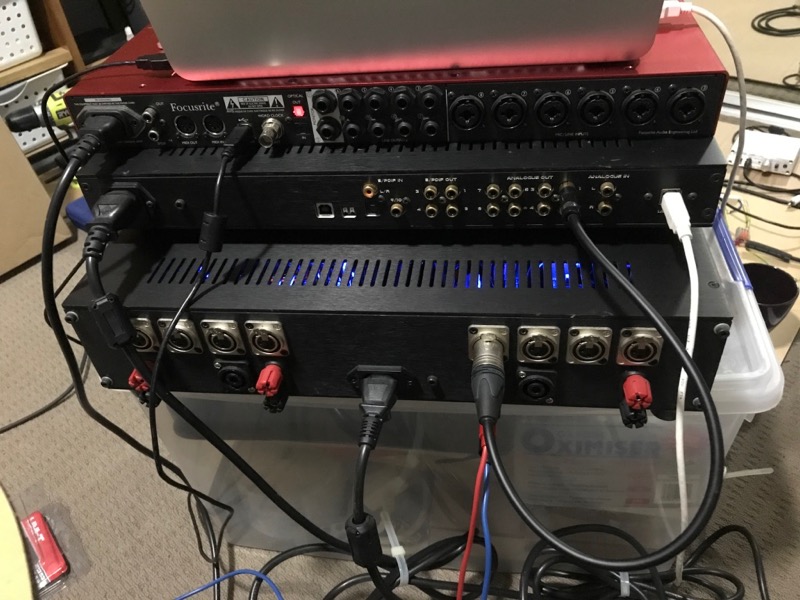
TC9 Cardboard Baffle
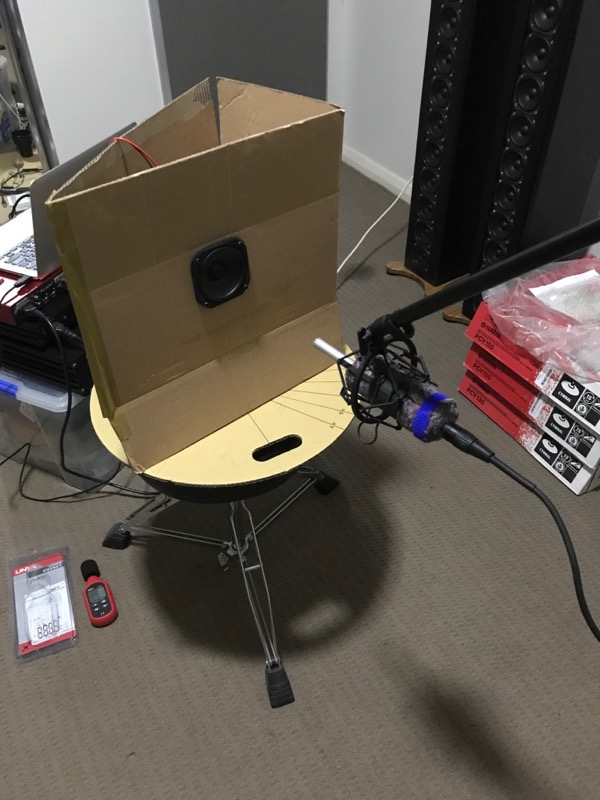
Mic in felt, inside mic mount that it was not designed for
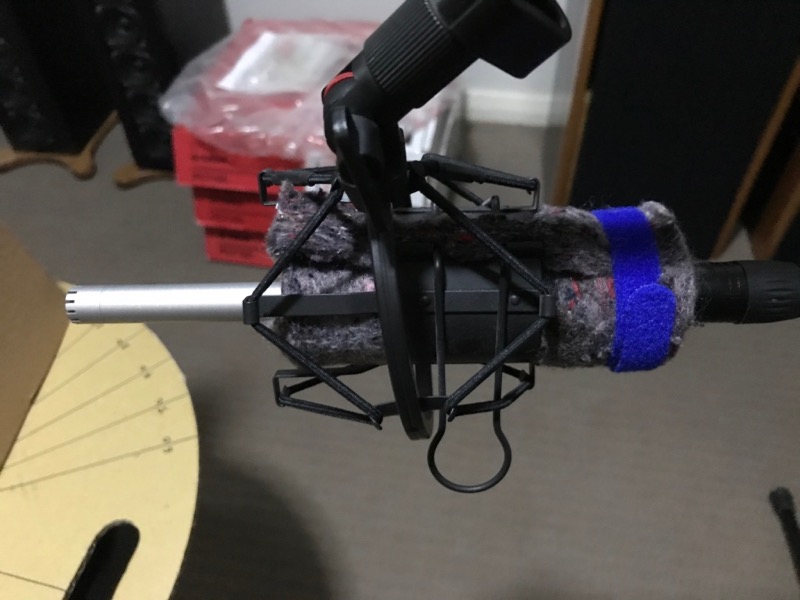
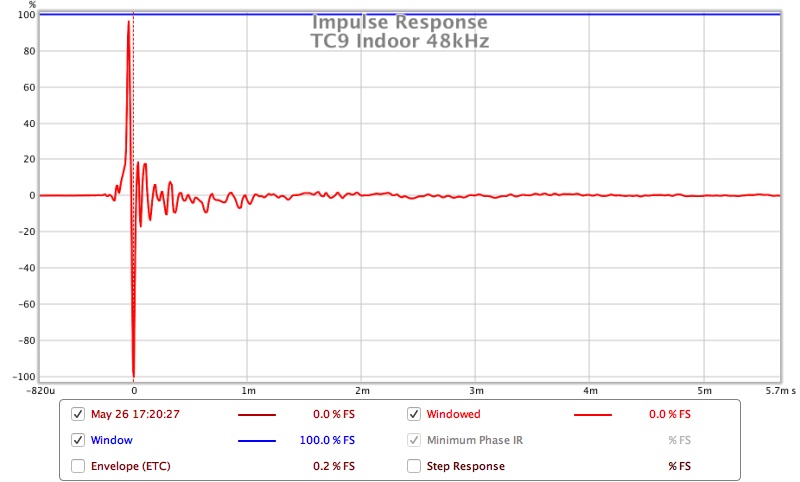
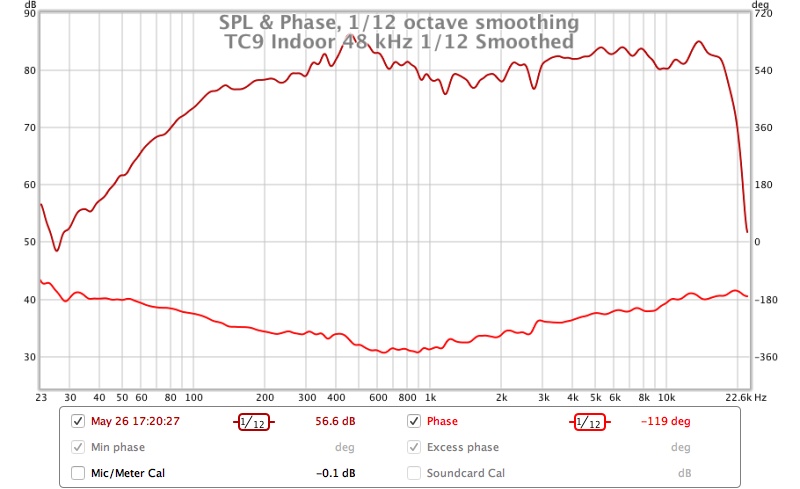
I might try reducing the mic gain and upping the measurement level to see if it makes a difference.
It could be that the SRC chip in the Najda is responsible regardless of the sample rate. I will try and test with another DAC although I don't have an analogue volume control in working order at the moment which might make that less successful.
Here are some better pictures of the test setup for Byrtt and the frequency response and impulse of the test measurement at 48kHz. And for Perceval it worked for me so maybe try the latest version of REW and see if it works for you.
Back of the test rig
TC9 Cardboard Baffle
Mic in felt, inside mic mount that it was not designed for
Attachments
News media brings it's own issues. Often the news broadcasters pass through a "clarity" filter which boosts in the 2kHz-4kHz range where much silibance of the human voice exists. This is supposed to make vowels and consonants more easily discernible to those hard of hearing. TV speakers are already high in this range, but on hifi two-way bookshelf speakers, the "clarity" boost can be painful.
I can hear from 12-17000Hz, extremely good for a 36 year old male, and absolutely do not need a "hearing aid EQ" 2-4kHz clarity boost applied to the broadcast, boosting the mid-treble region so that elderly people who are hard of hearing can better understand human speech. It's just grating to my ears, but the terrible acoustics of the built in speakers are by far worse.
(This human voice silibance is right in the 2.3kHz xover region of my Polks, and ironically I can turn off the woofers through the A/B select on my amp and despite the tweets sounding like buzzing mosquitoes, I can make out speech clearly despite the fundamental notes of the human vocal range are completely absent. And with the woofers by themselves it's like the person is talking though a pillow. So people who have trouble hearing to 4kHz may be at a real disability hence why news broadcasters boost this region.)
Sorry to go on about this off topic issue, when listening to the TV sound over speakers, were you using a Stereo pair of speakers? If so, the difference might not be the way they processed the sound but more related to the difference in perception of a phantom center vs a real center (or relatively close spaced TV speakers)
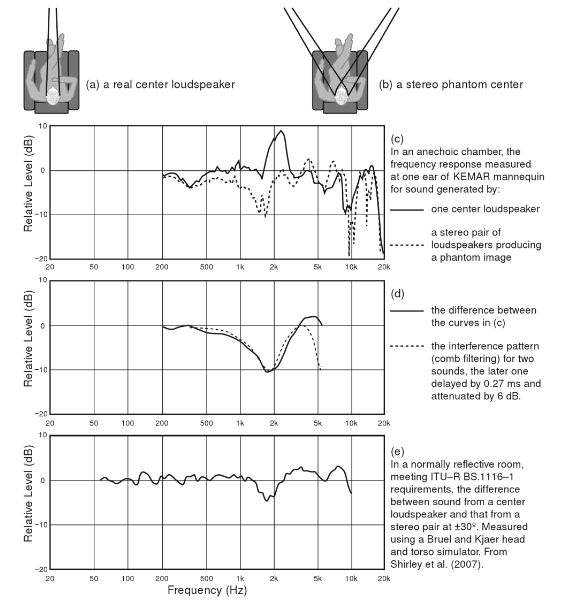
Center material mixed for a true center will sound different on a stereo setup.
Much like that "clarity boost" you talk about. Much more info is available in this thread.
Last edited:
Well it is not a mismatch in the sample rate causing the issue, I have tested with everything set to 48kHz and the part before the impulse is still lumpy. There is a pretty high background noise level in my house which I was not really aware of before putting a microphone in there.
I might try reducing the mic gain and upping the measurement level to see if it makes a difference.
It could be that the SRC chip in the Najda is responsible regardless of the sample rate. I will try and test with another DAC although I don't have an analogue volume control in working order at the moment which might make that less successful.
Here are some better pictures of the test setup for Byrtt and the frequency response and impulse of the test measurement at 48kHz. And for Perceval it worked for me so maybe try the latest version of REW and see if it works for you.
Back of the test rig

TC9 Cardboard Baffle

Mic in felt, inside mic mount that it was not designed for



It's strange though, the peak that hits 100% is the downward one.
Not like BYRTT's measurement:
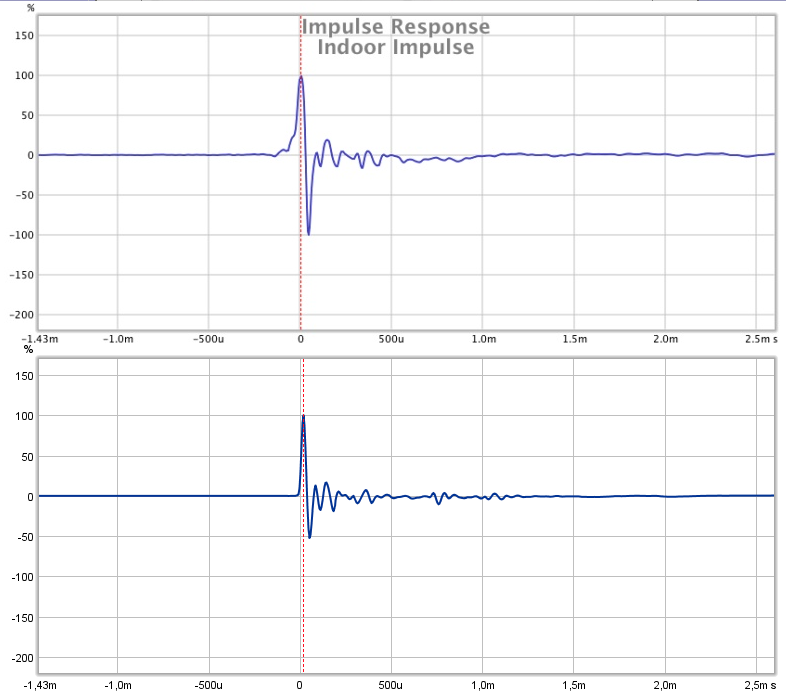
I do think it's caused by something in the chain somewhere. I've seen enough TC9 IR's to assume they should look like BYRTT's bottom example.
I'll add another thought, my DAC connected in USB mode never measured as cleanly as it did with SP/dif.
Last edited:
- Home
- Loudspeakers
- Full Range
- Full Range TC9 Line Array CNC Cabinet

